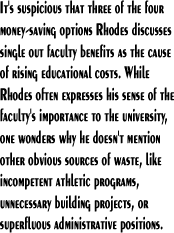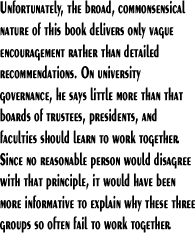2. Rhodes focuses mainly on the contemporary American research university, because he believes “it is the graduates of this small handful of universities on whom the nation depends for the success of its continuing everyday functions” (19). By limiting his scope to these institutions, Rhodes comes close to addressing a specific audience. Sometimes, however, it's uncertain who the projected audience of this book is supposed to be. The dust jacket has blurbs from several big-name university presidents and deans. But if this book is aimed at that highly specialized audience, its advice is too basic and obvious, and it often reads like a vague professional self-help manual. Much of the advice in this book rests on little more than the institutional authority of its author, and Rhodes seldom provides enough data or evidence that would convince skeptics of his more contestable claims. His evidence tends to be anecdotal, and he frequently relies on appeals to shared assumptions and values. But administrators who share Rhodes's assumptions in the first place won't need to read his book. While it might serve as a bromide they could take every now and then to sustain their emotional confidence in the midst of campus turmoil or occupational confusion, it doesn't provide substantive justifications for policies and procedures. That having been said, though, it may provide administrators with certain ideas, observations, and justifications that they might have either forgotten or overlooked.
3. Another audience Rhodes seems to address is anyone concerned about the rising costs of higher education. Perhaps predictably, his approach to this problem tends to favor the concerns of administrators over those of faculty members. To be sure, administrators need to worry about saving money while states cut budgets and parents or students fed up with skyrocketing tuition costs threaten to shop elsewhere for a more affordable education. But it's suspicious that three of the four money-saving options Rhodes discusses single out faculty benefits as the cause of rising educational costs. While Rhodes often expresses his sense of the faculty's importance to the university, one wonders why he doesn't mention other obvious sources of waste, like incompetent athletic programs, unnecessary building projects, or superfluous administrative positions.
4. His administrative slant also seems apparent in his discussion of tenure. For the last fifteen years, tenure has received a lot of media attention as a flawed, wasteful, and outdated academic practice. Part of Rhodes's solution to tenure problems involves requiring faculty members to take a professional oath. He admits, “It might be argued that this is unnecessary; that it is implicit in the professor's role. Implicit it is; but explicit it is not, and so abuses exist unchecked.” But he reasons that this “Socratic Oath” might serve as a counterpart to medicine's Hippocratic Oath, holding members of the same profession to a common standard. He even provides a version of what the oath could look like: “I hereby devote myself to the advancement and extension of knowledge, recognizing that I have an obligation to my students, to my discipline, to my professional colleagues, to my university, and to the public [etc.]” (157). If read in the properly idealistic tone, the oath's sentiments are admirable. But I wonder how a vaguely worded document like this could keep potential abuses in check or change anyone's general understanding of what it means to be a college professor. Plenty of academics who already have that understanding wouldn't alter their conduct one bit even if they had to sign such an oath. Cynical, self-serving careerists quickly figure out how university politics and professional survival actually work, and making such people take this oath would just be enforcing a meaningless ritual.
5. Setting all this aside, Rhodes's insistence on the importance of undergraduate education is unmistakable and admirable. He repeatedly and eloquently stresses that undergraduate instruction remains the central task of the university. He also wisely observes that corporate models of management and professionalization shouldn't be allowed to override the traditional “human scale” of higher education: “These models, designed to create standardized, efficient, simplified production processes, with tight control and central planning, and a narrow focus on instrumental learning and bottom-line results, are more likely to corrode the foundation of the university than to improve its performance” (48). He does note the growing influence of information technology and its capability of transforming the university into a more business-like institution. But he rejects the view of students as mere customers and learning as merely instrumental and occupational. While he thinks that universities should both adapt to and compete with changing approaches to education, one of his most successful and penetrating sections details the educational, social, and moral costs of reducing higher learning to a narrowly professional endeavor.
6. In his chapter on governance and leadership, one would expect Rhodes's extensive experience to produce valuable advice for his administrative audience. But unfortunately, the broad, commonsensical nature of this book delivers only vague encouragement rather than detailed recommendations. On university governance, he says little more than that boards of trustees, presidents, and faculties should learn to work together. Since no reasonable person would disagree with that principle, it would have been more informative to explain why these three groups so often fail to work together.
7. If this book is intended for university presidents, it says little more than “Set goals, convey trust to your employees, keep up with the times, and lead well.” While he cites some examples of typical conflicts between faculties and boards of trustees, his narratives and discussions of these examples are so brief as to be uninstructive. Self-evidently, he observes that the key to resolving campus conflicts is “presidential leadership, exercised on a basis of mutual trust, understanding, and respect developed over time with both the board and the faculty” (219). If this is advice for university presidents, all it really boils down to is this: “Convey a sense of trust to those you deal with.” Here's another example of his leadership advice: “It is the responsibility of the president, not only to explain the role and concerns of the board to the campus community, but also to interpret for the board the distinctive role and concerns of the faculty and other members of the campus community” (222). If any president needs to be reminded of principles like this, something went seriously wrong to put such an ignoramus into office.
8. Despite his administrative focus, Rhodes occasionally acknowledges that “the faculty, in one sense, are the university.” But soon thereafter he resumes administrative side-taking, observing that “faculty loyalty has tended to drift from the university toward external professional guilds, funding agencies, corporate sponsors, and private patrons, so that institutional engagement of faculty members has declined.” Instead of speculating why this drift of loyalty might have occurred, or wondering whether it's the result of administrations shirking their responsibilities to the faculties they were created to serve, he concludes with this broad, and ultimately empty, sentiment: “The solution is for all three governing entities--trustees, president, faculty--to clarify their roles, develop trust, and exercise leadership” (216-17). Again, any trustees, presidents, or faculty members who need to be reminded of something so self-evident aren't worthy of their positions.
9. A lot of Rhodes's other analyses of campus issues--e.g., affirmative action, corporate influence, undergraduate curricula--fail to offer anything more than what's already been said in academic, and even mainstream, journalism. I found myself wanting to see more extensively documented and justified policy recommendations, or at least outrageously original claims that might unsettle my perspective on familiar issues. Rhodes's book could have used more of the thick anecdotal detail to be found in books like Cary Nelson's Manifesto of a Tenured Radical (1997) or Alvin Kernan's In Plato's Cave (2000). One need not accept the obvious agendas of these writers to learn something from their detailed accounts. By contrast, Rhodes delivers little more than the vague assurance that a properly optimistic frame of mind will help you realize the educational goals you and he already share.
10. In his Socratic Oath and elsewhere, Rhodes argues that faculty members should “embark on teaching as a moral vocation.” The problem, here and throughout this book, is that words like “moral” can carry so many contradictory meanings that Rhodes's broadly formulated principles could justify any number of competing approaches to campus problems and professional conduct. For example, his elliptic argument against faculty unionization alludes to this ideal of teaching as a moral vocation: “I confess that I find it difficult to reconcile the professional responsibilities of the professor or teaching assistant with union membership.” After alluding to his own unpleasant experiences with unionization and contract negotiations, he adds, “Whatever the alleged benefits to their members, I regard such unions as a divisive and destructive influence on the university community” (66).
11. As an underpaid part-time professor who shares Rhodes's view of teaching as a moral vocation but who is also uncertain about the relative advantages and disadvantages of unions, I wanted to see much more discussion of issues like this. Instead, I couldn't help but suspect Rhodes for using this lofty view of higher education to suggest that teaching assistants and professors should know their place on campus and stop bugging administrators for more resources and funding. He concludes this very brief discussion by claiming that “faculty and graduate student unions are a corrosive campus influence because they promote a narrow view of the teacher's role” (67). Since he merely asserts but doesn't at all justify this claim, he misses an important rhetorical opportunity to assure poorly compensated academic laborers that administrators are actually willing to do something to improve their working conditions. If administrators don't provide this assurance themselves--not just in words and books but deeds and policies--then it should come as no surprise that professors and teaching assistants will try to acquire it through other channels.
|
|

|
|

|
|
